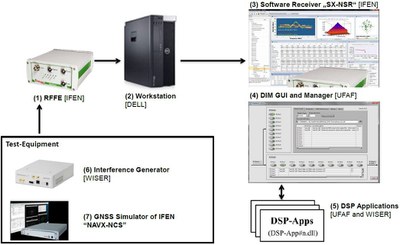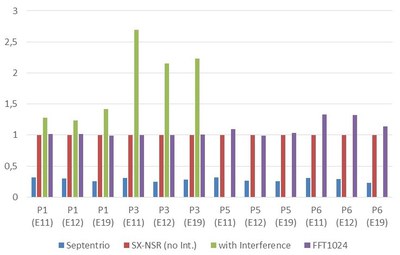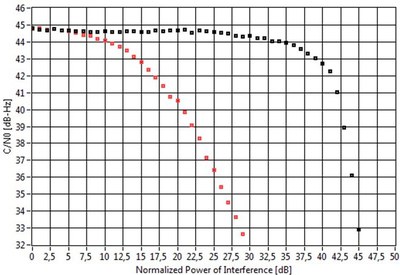TERMINATE
Interference Mitigation Based on Novel Signal Processing Cancelation and RF Front End
Objective is to investigate a future GNSS receiver design offering a visibly superior interference detection and rejection capability compared to that typically achieved by state of the art commercial GNSS receivers
Details:
Intentional and unintentional interference is a relevant error source affecting the accuracy, integrity, continuity and availability of GNSS services. Novel DSP algorithms are promising to enable a visibly superior interference detection and rejection capability for future GNSS receivers. In order to assess and demonstrate their capability in detection, identification, and mitigation of common interference sources, a Concept Demonstrator (CD) has been developed. The CD is based on a commercial high-performance software receiver (SX-NSR from IFEN GmbH) with an improved RF‑FE hardware, providing a high signal dynamic and a unique out-of-band signal rejection capability. The CD has been designed for L1/E1 with the potential for the extension of other GNSS bands and alternative front-ends.

Overview of the concept demonstrator
Algorithms included in the concept demonstrator are:
- AGC (fast/slow mode, Pulse Blanking)
- Statistical Tests
- FIR and IIR filter (for time-stationary "standard" and time-varying "adaptive")
- "Short-Time" Fourier Transform (FFT and STFT)
- Fractional Fourier Transform (FrFT)
- Wavelet Transform (WT)
- Karhunen-Lòeve-Transform (KLT)
- Signal Tracking and Suppression (not part of the TERMINATE project)
Even that the project is just focusing on the L1/E1 band, any well-known types of interferences from other bands were implemented and tested in E1. Of course, the influence of interferences also depends on the types of GNSS signal modulations, but the concept of pre-correlation detection and mitigation is independent to the bands itself. The interference generator, developed by WISER, is based on an ETTUS N210 or NI USRP 29xx devices and can also generate the signals in any other GNSS bands. It can generate up to six interferences simultaneously and contains continuous wave, narrowband and width-band noise, DME, Radar, UWB and chirp signals (simulation of PPDs).
 |
 |
|
Relative code-tracking error without |
C/N0 without mitigation in red and with mitigation in black |
|
Contact: Funded by: Duration: Cooperation:
|
European Space Agency (ESA-ESTEC) July 2012 - End 2014 IFEN GmbH (Germany), WISER S.r.l. (Italy)
|